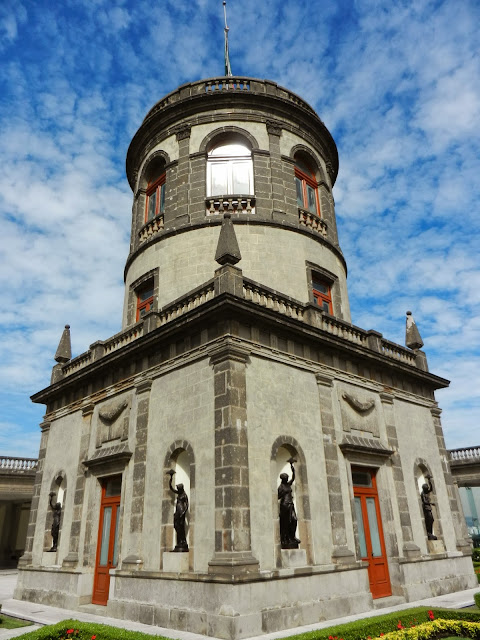One sunny September morning, I visited a portion of Section One of the park. Chapultepec Park has three sections, and visiting them all could take well up to a week. I had 5-6 hours to visit the castle, zoo, and some monuments in Section One.
 |
| A view of the castle atop the hill |
 |
| Many of the interior castle walls are covered in murals depicting the history of Mexico. |
 |
| In one wing of the castle, all of the original furniture and decorations are still in place. |
 |
 |
| Originally built as a watchtower for the Mexican Military, this structure later served as an observatory. |
If you are interested in the castle's history...here is a very choppy, rough-draft, short version of the story:
Construction began in 1785, as ordered in 1784 by Viceroy Matias de Galvez. Following the Viceroy's death soon after, his son, Count Bernardo de Galvez, ordered construction to continue. However, when he died two years later, the Spanish court/crown ordered architects to stop the project because they were uneasy about the pro-independence movement in Mexico. The construction was abandoned and the castle remained unoccupied until 1841, years after the Mexican Revolution and Independence, when it was used to train army officers. In 1847, the U.S. invaded Mexico, and the castle was defended (and lost) by the soldiers and cadets who were studying at the academy during that time. After the conclusion of the war where Mexico lost half of its northern territory to the U.S., the castle was returned to the Military Academy. Starting in 1859, the castle was used to house military generals. During the French Intervention in 1864, the castle was used to house Archduke Maximilian, who was named emperor of Mexico shortly following his arrival. Maximilian had the castle's construction fully completed. Eventually, however, due to his inability to please either political party, the Archduke/Emperor was executed by Benito Juarez in 1867. From 1876 to 1883, the castle served as the grounds for an astronomical, meteorological, and magnetic observatory. In 1881, Porfirio Diaz had another wing added to the castle for the Military Academy. A few years later in 1877, Porfirio Diaz was made President of Mexico, and he adopted the castle as a summer residence. The castle served as the military academy training / presidential manor until 1917; and as solely a presidential manor until 1939, when President Lazaro Cardenas proclaimed the castle as the headquarters for the National History Museum.
After leaving the castle and all its history behind, I made my way to the zoo. Passing one of the lakes on my way, I made a mental note to try out the paddle-boating there sometime.
At the zoo: I'm sure you've all seen about 300 million zoo pictures, so I'll only add two--black bears getting ready to play-fight and lions being lazy. But, the Chapultepec Zoo is really large, and has tons of different species!
Exiting the zoo and taking the long way back to the exit, I walked along a quiet path and passed many fountains and a couple monuments.
 |
| Idyllic Chapultepec |
Though I did cover a lot of ground in the park, I missed out on 6 museums in Section One, as well as botanical gardens, the Korean Gazebo, Gandhi Park, the lakes, other monuments...well, there's a lot more for me to see. Until another day, Chapultepec Park!



































